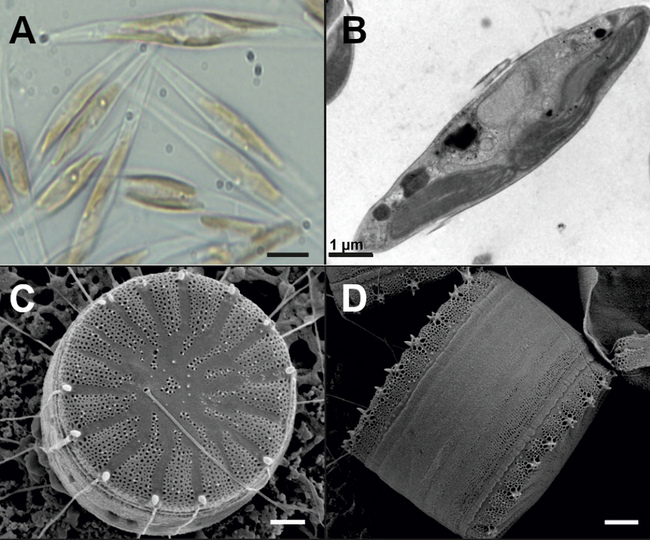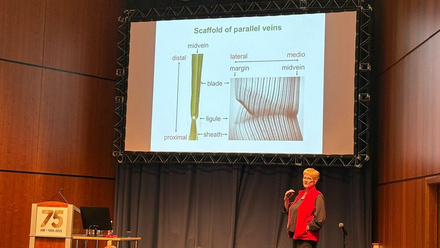JXB Volume 73, Issue 7 – Editor’s choice
JXB Volume 73, Issue 7 – Editor’s choice
This article highlights the following publication:
The C-terminus of a diatom plant-like cryptochrome influences the FAD redox state and binding of interaction partners
Julia Krischer, Sarah König, Wolfram Weisheit, Maria Mittag, Claudia Büchel
Journal of Experimental Botany, Volume 73, Issue 7, 5 April 2022, Pages 1934–1948, https://doi.org/10.1093/jxb/erac012
Cryptochrome light signalling: How diatoms look on the bright side of life
Beauty may proverbially lie within the eye of the beholder, yet the natural world has visual treats to offer whose aesthetic appeals remain widely undisputed. The iridescent feathers of a peacock’s tail, the delicate flowers of Japanese cherry blossoms, or the brightly coloured wings of a Monarch butterfly all have intriguing allure for most people. The same is true for diatoms, the so-called “jewels of the sea”, whose natural beauty has mesmerized humans for many centuries. Even the great naturalist and father of the theory of evolution Charles Darwin found special delight in these microscopically small, unicellular microalgae that can be found in pretty much any aquatic environment on earth such as oceans, fresh water habitats, and soil. Their cell walls are made of silicon dioxide and form highly symmetrical patterns. It was this artfully designed, intricate outer skeleton which intrigued Charles Darwin and let him question the process of natural selection for a moment when he wondered in his masterpiece “On the Origin of Species”: "Few objects are more beautiful than the minute siliceous cases of the diatomaceæ: were these created that they might be examined and admired under the higher powers of the microscope?". A rational thinker through and through, Darwin’s answer was less romantic, and he reasoned that “natural selection can produce nothing in one species for the exclusive good or injury of another”. Even though diatoms have not deliberately been created for being examined under the microscope, they make fantastic objects of study, and after decades of research we now know that the transparent, porous cell walls with highly uniform ultrastructure (Figure 1) have mechanical, optical, and hydrodynamic properties adapted to their aquatic environments.

Diatoms have received much scientific attention due to their significance for the global atmosphere, biosphere, and geosphere. Their photosynthetic activity generates over 20 percent of the annual oxygen produced on earth and absorbs several billion tons of CO2 per year. As a major component of phytoplankton, they form the basis of many food webs, and any change in their primary production will thus have far-reaching consequences, making them targets of intense ecological and ecophysiological research. Diatoms have been colonising the planet for over 200 million years and since their silica shells do not decompose post mortem, their microfossils serve geologists and paleolimnologists in their study of earth’s history.
The phylogenetic group of diatoms comprises at least 100,000 different species, and since genetic transformation of diatoms has only been established in the mid-nineties of the last century, they are only rudimentarily understood on a genetic and molecular level.
In this issue of the Journal of Experimental Botany Krischer et al. (2022) fill some of our knowledge gaps by giving a detailed description of the diatomaceous photoreceptor CryP, which belongs to the cryptochrome/photolyase family. Cryptochromes are blue light receptors found in many organisms where they have diverse functions, such as control of developmental processes in plants, and perception of magnetic fields in migrating birds, to name just a few. Their role in diatoms, however, has so far remained mostly unknown. Knowledge transfer from the well-described cryptochromes of higher plants (CRYs) proves to be difficult for several reasons. The cryptochrome-regulated responses in sporophytes are not relevant in unicellular microalgae, and the CRY-interacting factors identified in plants have no direct orthologues in diatoms. It is known that, just like plant CRYs, diatom CryP binds flavin as a light-absorbing chromophore, and can additionally contain the chromophore 5,10-methenyltetrahydrofolate. Flavin exists in different redox states with characteristic light absorption spectra. Krischer et al. performed spectroscopic analysis of isolated CryP and found that, in contrast to plant CRYs, semireduced flavin (FADH•) is the most stable state of the chromophore and this is reached within minutes of blue light illumination. The oxidized state (FADox) was induced and stable only after several days in complete darkness, and the authors therefore reason that in vivo, FADH• may be the major form bound to CryP not only during the day but also at night. In CRYs of higher plants, by contrast, the oxidized flavin is the normal dark state. Semireduced FADH• absorbs not only blue but also yellow and red light and the authors therefore speculate that CryP may be involved in the regulation of night/day transition in diatoms. This is in accordance with previous studies showing high CryP expression shortly before dawn.
Krischer et al. further show that the C-terminal extension of the protein is essential in order for CryP to bind flavin and allow for its redox change. Truncated CryP lacking this domain could only bind FADox and blue light was not sufficient for flavin reduction. Moreover, diatom CryP formed dimers and oligomers, presumably through electrostatic interactions, yet unlike plant CRYs, CryP dimerization was light-independent.
Previous work from the same group showed that CryP changes the expression of numerous genes (Koenig et al., 2017). The authors now confirm that direct DNA interaction is an unlikely mode of action for this photoreceptor. CryP could bind to DNA but this was found to be not specific, making it more likely that CryP acts through binding to other proteins instead of being a classical transcription factor. The authors identified several CryP interacting partners that show differences in the binding characteristics with respect to the redox state of the flavin and the dimerization state of the CryP protein. However, little is known about the function of these interacting proteins yet and will thus be subject of future research.
The work presented by Krischer et al. highlights how special diatoms are in many respects. Not only is their silica skeleton a unique feature across all realms of life, but also what goes on behind these walls of glass is unlike what we know from higher plants. A better understanding of the internal workings of these extraordinary organisms will hopefully add to our love of their superficial appearance an admiration of their inner beauty.





